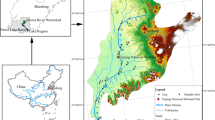Abstract
Atrazine (2-chloro-4-ethylamino-6-isopropylamino-s-triazine) andN-deethylated atrazine (2-chloro-4-amino-6-isopropylamino-s-triazine) were monitored (1974 and 1975) in five rivers which drained agricultural areas in the Yamaska river basin of Québec. Water samples were collected frequently from April to December each year from sites near the outflow of each river. The water samples were extracted with benzene, chloroform, or ethyl acetate and the extracts were analyzed by gas chromatography using a Hall electrolytic conductivity detector and an alkali-flame detector.
Atrazine andN-deethylated atrazine residues ranged in concentration from 0.01 to 26.9 μg/L and <0.01 to 1.34 μg/L, respectively, over the monitoring period. The highest levels of atrazine were observed in July each year and they coincided with the herbicide spraying season in this region and with occasional heavy rainfall events. Discharges (kg/yr) of atrazine from the five rivers were related to corn-growing area in each watershed. Losses of atrazine ranged from 0.1 to 2.9% of the atrazine that was estimated to have been applied in each watershed.
Similar content being viewed by others
References
Behrens, R.: Corn and weeds. Weeds Today (Late Winter Issue), 15 (1975).
Caillé, A., P. G. Campbell, D. Cluis, P. Couture, and L. Talbot: Impact de l'agriculture sur la qualité des eaux de surface de la rivière Yamaska. Rapport final. Version préliminaire.IRNS-Eau, Ste. Foy, Québec (1975).
Caro, J. H., H. P. Freeman, D. E. Gotfelty, B. C. Turner, and W. M. Edwards: Dissipation of soil-incorporated carbofuran in the field. J. Agr. Food Chem.21, 1010 (1973).
Caro, J. H., H. P. Freeman, and B. C. Turner: Persistence in soil and losses in runoff of soil-incorporated carbaryl in a small watershed. J. Agr. Food Chem.22, 860 (1974).
Feltz, H. R., and J. K. Culbertson: Sampling procedures and problems in determining pesticide residues in the hydrologic environment. Pestic. Monit. J.6, 171 (1972).
Frere, M. H.: Requisite sampling frequency for measuring nutrient and pesticide movement with runoff waters. J. Agr. Food Chem.19, 837 (1971).
Gray, D. M.: Handbook on the principles of hydrology.Can. Commit. for the Int'l Hydrolog. Decade, Ottawa (1970).
Hall, J. K. Erosional losses of s-triazine herbicides: J. Environ. Qual.3, 174 (1974).
Hall, J. K., M. Pawlus, and E. R. Higgins: Losses of atrazine in runoff water and soil sediment. J. Environ. Qual.1, 172 (1972).
Harris, C. R., and J. R. W. Miles: Pesticide residues in the Great Lakes region of Canada. Residue Reviews59, 27 (1975).
Hollister, T. A., and G. E. Walsh: Differential responses of marine phytoplankton to herbicides: oxygen evolution. Bull. Environ. Contam. Toxicol.9, 291 (1973).
Lawrence, J. F.: Confirmation techniques for triazine herbicides by gas chromatography with electrolytic conductivity detection. J. Agr. Food Chem.22, 936 (1974).
Macek, K. J., K. S. Buxton, S. Sauter, S. Gnilka, and J. W. Dean: Chronic toxicity of atrazine to selected aquatic invertebrates and fishes.U.S. EPA Report No. 600/3-76-047,U.S. EPA Office of Research and Development, Washington, D.C. (1976).
Miles, J. R. W., E. F. Bolton, and C. R. Harris: Insecticide and nutrient transport in water, related to agricultural land use of a stream basin in Ontario, Canada. Arch. Environ. Contam. Toxicol.5, 119 (1977).
Muir, D. C., and B. E. Baker: Detection of triazine herbicides and their degradation products in tile-drain water from fields under intensive corn (maize) production. J. Agr. Food Chem.24, 122 (1976).
Muir, D. C. G., and B. E. Baker: Appearance and disappearance of several degradation products of atrazine and cyanazine in soil under field conditions. Proc. West. Canada Workshop on Chemistry and Biochemistry of Pesticides, Winnipeg (1977).
Newby, L., and B. G. Tweedy: Atrazine residues in major rivers and tributaries. Presented at the 172nd ACS National Meeting, San Francisco, PEST 102 (1976).
Potvin, L.: Inventoire de la pollution agricole dans le bassin de la rivière Yamaska.Services de Protection de l'Environnement, Québec (1974).
Richard, J. J., G. A. Junk, M. J. Avery, N. L. Nehring, J. S. Fritz, and H. J. Svec: Analysis of various Iowa waters for selected pesticides: atrazine, DDE and dieldrin—1974. Pestic. Monit. J.9, 117 (1975).
Ripley, B. D., R. J. Wilkinson, and A. S. Y. Chau: Multiresidue analysis of fourteen organophosphorus pesticides in natural waters. J. Ass. Offic. Anal. Chem.57, 1033 (1974).
Ritter, W. F., J. P. Johnson, W. G. Lovely, and M. Molnau: Atrazine, propachlor and diazinon residues on small agricultural watersheds. Runoff losses, persistence and movement. Environ. Sci. Technol.8, 38 (1974).
Shimabukuro, R. H.: Significance of atrazine dealkylation in root and shoot of pea plants. J. Agr. Food Chem.15, 557 (1967).
Sirons, G. J., R. Frank, and T. Sawyer: Residues of atrazine, cyanazine and their phytotoxic metabolites in a clay loam. J. Agr. Food Chem.21, 1016 (1973).
U.S. EPA: Draft analytical report. New Orleans area water supply. Prepared by the lower Mississippi River Facility. Slidell, La. Surveillance and Analysis Division.U.S. EPA, Dallas, Texas (1974).
Von Rumker, R., G. L. Kelso, F. Horay, and K. A. Lawrence: A study of the efficiency of the use of pesticides in agriculture.U.S. EPA Report No. 540/9-75-025. Nat'l Tech. Info. Ser., Washington, D.C. (1975).
Waldron, A. C.: Pesticide movement from cropland into Lake Erie.U.S. EPA Report No. 660/2-74-032.U.S. EPA Office of Research and Development, Washington, D.C. (1974).
White, A. W., A. P. Bamett, B. G. Wright, and J. H. Holladay: Atrazine losses from fallow land caused by runoff and erosion. Environ. Sci. Technol.1, 740 (1967).
Willis, G. H., R. L. Rodgers, and L. M. Southwick: Losses of diuron, linuron, fenac and trifluralin in surface drainage water. J. Environ. Qual.4, 399 (1975).
Author information
Authors and Affiliations
Rights and permissions
About this article
Cite this article
Muir, D.C.G., Yoo, J.Y. & Baker, B.E. Residues of Atrazine andN-deethylated Atrazine in water from five agricultural watersheds in Québec. Arch. Environ. Contam. Toxicol. 7, 221–235 (1978). https://doi.org/10.1007/BF02332051
Received:
Accepted:
Issue Date:
DOI: https://doi.org/10.1007/BF02332051




